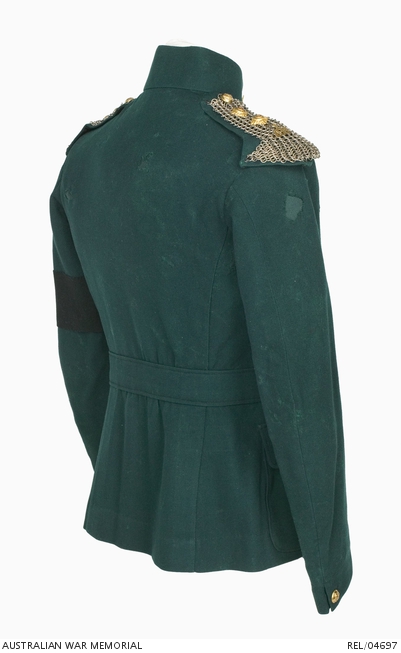| Place | Oceania: Australia, New South Wales |
|---|---|
| Accession Number | REL/04697 |
| Collection type | Heraldry |
| Object type | Uniform |
| Physical description | Cotton twill, Ferrous metal, Gilded brass, Linen, Wool twill |
| Maker |
Hobson and Sons |
| Place made | United Kingdom: England, Greater London, London |
| Date made | c 1898-1901 |
| Conflict |
Australian Colonial Forces, 1854-1900 |
Service dress tunic : Lieutenant J B N Osborne, 1st Australian Horse



Myrtle green wool twill Norfolk style tunic with high stand collar. Plain collar has the gilded brass badges of the 1st Australian Horse at each edge and is fastened with two ferrous metal hooks and eyes. Broad shoulder straps are of myrtle green cloth with ferrous metal chain mail attached with metal hooks and eyes. Each strap bears a gilded metal '1AH' title, two gilded brass and enamel stars for the rank of lieutenant and a small gilded brass 1st Australian Horse button. Plain cuffs have a small opening at the outer edge of sleeve fastened with a small single button of the same type. Stitched to the left sleeve is a wide black wool armband to mark the death of Queen Victoria in January 1901. Tunic has vertical pleats close to the centre fronts, each with a concealed welt pocket inside each breast lined with brown cotton twill and fastened with a single plastic button. Front fastens with five gilded brass Australian Horse buttons made by 'HOBSON & SONS LEXINGTON ST. LONDON'; the lowest of these is stitched to the belt flap of the attached myrtle green waist belt. Beneath this on the tunic is a fabric covered 'FAST SHANK' button. Lower down the skirt front is a ferrous metal hook and eye to secure the bottom of the tunic. On each front, beneath the line of the belt, is a rounded patch pocket with unbuttoned flap. Stitched to the left breast is the silk medal ribbon for the Queen's South Africa Medal. Tunic is unlined except for strips of brown linen across the back of the pockets to the side seams. Collar is lined with black wool and cotton mixture, with five small white plastic buttons stitched across the centre for the attachment of a separate collar. Maker's label stitched at back neck.
Service dress tunic worn by Lieutenant James Bunbury Nott Osborne as a member of the 1st Australian Horse. Born on 14 May 1878, and educated at Rugby College in England, Osborne was commissioned into the 1st Australian Horse on 1 January 1898. During the Boer War the Australian Horse provided two contingents, in 1899 and 1900. Osborne served as second in command with the first contingent, arriving in Cape Town on 13 December 1899. He was present at the relief of Kimberley and while there left the Australian Horse and took up a commission with the British 16th Lancers. He was closely involved in the surrender of Bloemfontein. Osborne served operations in Orange Free State and Transvaal from January 1900 to November 1900 and saw action at Reit River, Klip Drift, Relief of Kimberley, Paardeberg, Poplar Grove, Dreifontein, Karee Siding, Belfast and Slingersfontein. He was awarded the Queen's medal with five clasps. Aflter becoming ill, he was invalided to England. Osborne eventually returned to Australia and took up the family property 'Bowylie', Gundaroo, in NSW. He died in 1934. The presence of the mourning band for Queen Victoria dates this uniform to February-March 1901, as the army in Australia wore official mourning for six weeks from the beginning of February.